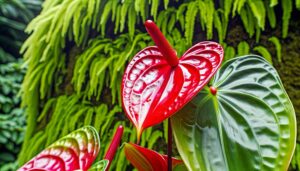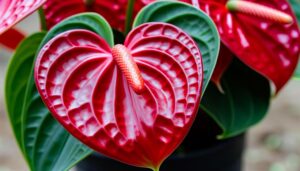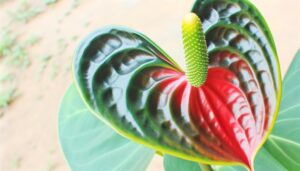Anthurium King of Kings – The Ultimate Care Guide
To guarantee your Anthurium ‘King of Kings’ thrives, place it in bright, indirect light near an east or north-facing window. Use lukewarm, filtered water and hydrate every 1-2 weeks, adjusting for humidity.
Opt for a well-ventilated soil mix with orchid bark, perlite, and peat moss, maintaining a pH between 5.5 and 6.5. Fertilize with a diluted, balanced, water-soluble fertilizer every 6-8 weeks to encourage growth.
Inspect for pests regularly and treat with insecticidal soap or neem oil if needed. For more on maximizing the health of your Anthurium, consider best practices for each care aspect.

Key Takeaways
- Place Anthurium King of Kings in bright, indirect light near an east or north-facing window.
- Water every 1-2 weeks with lukewarm, filtered water, ensuring soil is moist but not waterlogged.
- Use a well-draining soil mix with orchid bark, perlite, and peat moss, and maintain pH levels between 5.5 and 6.5.
- Fertilize every 6-8 weeks with a diluted, balanced, water-soluble fertilizer applied directly to the soil in the morning.
- Regularly inspect for pests and treat with insecticidal soap or neem oil, isolating the plant if necessary.
Ideal Lighting Conditions

To achieve best growth for your anthurium, place it in bright, indirect light to mimic its natural rainforest understory habitat. Direct sunlight can scorch the leaves, leading to chlorosis and reduced photosynthetic efficiency. Position your plant near an east or north-facing window where it receives diffused light.
If natural light is insufficient, you can use fluorescent grow lights, maintaining an intensity of 10,000-20,000 lux. The leaf blades contain chloroplasts that need adequate light for best photosynthesis, producing the energy required for growth and flowering.
Watering Routine
Maintaining an ideal watering schedule for your anthurium is essential. Overwatering can lead to root rot, while underwatering may cause dehydration and stress.
To achieve the best hydration, follow these detailed steps:
- Check Soil Moisture: Insert your finger about 1-2 inches into the soil. If it feels dry, it’s time to water.
- Watering Method: Use lukewarm, filtered water to prevent shocking the roots. Water thoroughly until excess drains out from the bottom.
- Frequency: Water every 1-2 weeks, adjusting based on humidity levels and seasonal changes.
Soil Preferences
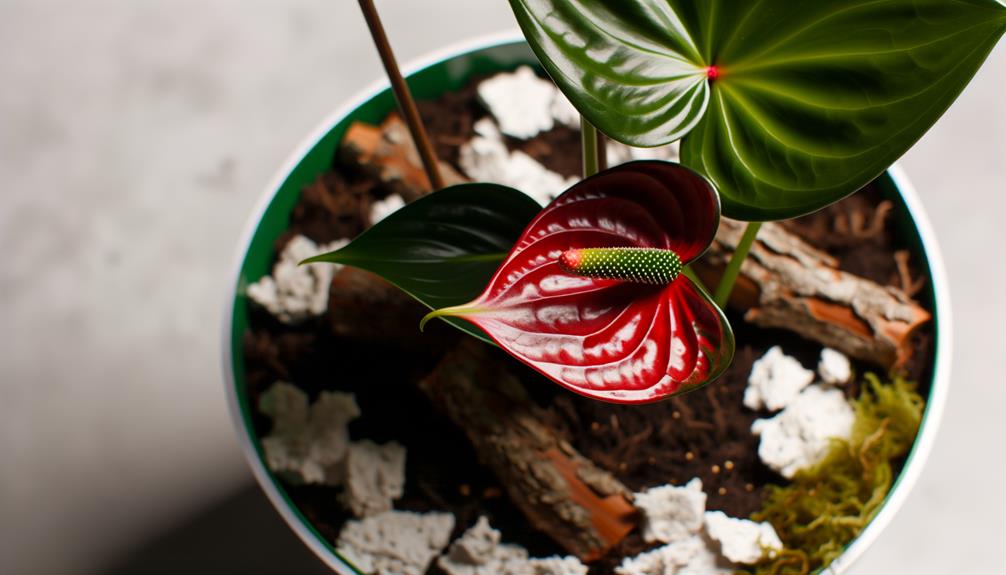
For perfect growth and nutrient absorption, anthuriums need a well-ventilated, well-draining soil mix rich in organic matter. Select a blend containing orchid bark, perlite, and peat moss. This combination guarantees root aeration, preventing compaction and root rot.
Orchid bark provides structural support and air pockets, while perlite enhances drainage, and peat moss retains necessary moisture and nutrients.
Mixing your own? Use 60% orchid bark, 20% perlite, and 20% peat moss. Maintain the pH levels between 5.5 and 6.5 for optimal nutrient uptake. Avoid dense, clay-based soils; they restrict root growth and suffocate the plant.
Repot every two years to refresh the medium and maintain soil quality. This ensures your anthurium thrives, rewarding you with lush foliage and vibrant blooms.
Fertilizing Tips
Although anthuriums don’t need heavy feeding, providing them with a balanced, water-soluble fertilizer every 6-8 weeks during the growing season promotes robust growth and vibrant blooms.
Follow these guidelines for ideal results:
- Concentration: Dilute the fertilizer to half-strength to avoid root burn, ensuring nutrients are accessible without overwhelming the plant’s physiology.
- Application: Apply the solution directly to the soil, not the leaves, to facilitate efficient nutrient uptake through the root system.
- Timing: Fertilize in the morning when stomata are open, enhancing nutrient absorption and minimizing evaporation.
Pest Control
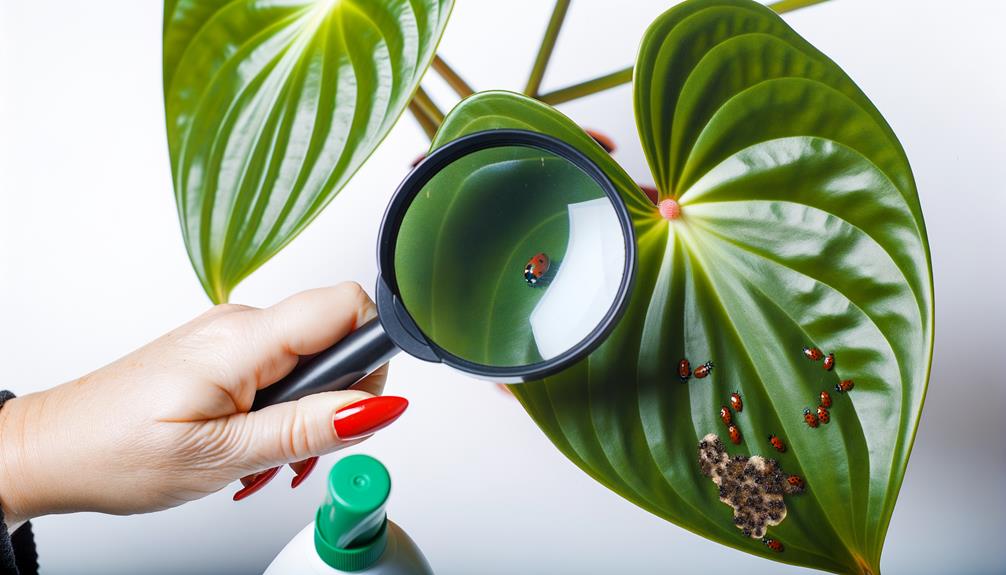
Effective pest control for anthuriums starts with vigilance and early detection to prevent infestations from compromising plant health. Regularly inspect leaves and stems for signs of pests like aphids, mealybugs, and spider mites.
Use a magnifying glass to spot early infestations. If you find pests, isolate the affected plant to prevent spread.
Wash the plant with insecticidal soap or neem oil, focusing on leaf undersides and stem joints. Guarantee proper ventilation to reduce humidity, which can deter pests.
| Pest | Control Method |
|---|---|
| Aphids | Insecticidal soap |
| Mealybugs | Neem oil |
| Spider Mites | Miticide |
| Scale | Rubbing alcohol swabs |
| Thrips | Sticky traps |
Always maintain cleanliness in your growing area to secure a healthy anthurium.
Conclusion
Caring for your Anthurium ‘King of Kings‘ isn’t a Herculean task if you follow these guidelines. With proper lighting, a diligent watering routine, suitable soil, and regular feeding, your plant will thrive like a royal heir to the throne.
Keep pests at bay with vigilance, and you’ll secure your Anthurium reigns supreme. Remember, even the mightiest of kings needs the right environment to flourish.
So, treat your plant like royalty, and it’ll reward you handsomely.


